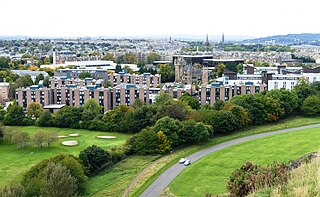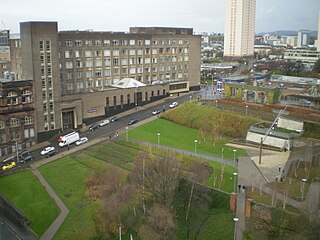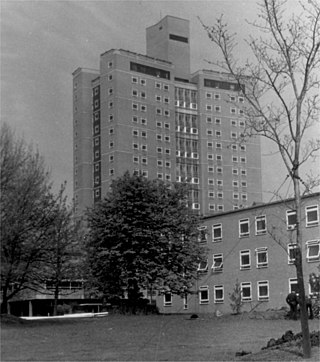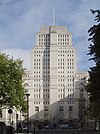
This is a list of halls of residence on the various campuses of the University of Nottingham in Nottingham, England.

Carrington College is a residential college of the University of Otago. This complex of buildings has accommodation for 243 students and was opened in 1945. It was the first university hall of residence in Australasia to accept both male and female students. It is named for G.W. Carrington, a former head of the Otago Education Board. The current Warden is Ali Norton.

The University of Exeter offers approximately 5,900 purposebuilt student bed spaces for its students. The majority of its residences are located on campus, although 30% of self-catered accommodations are located off-campus.

Capernwray Hall is a former country house situated 3 miles east-northeast of Carnforth, Lancashire, England, and is currently used as a Christian Bible school and holiday centre. The house is recorded in the National Heritage List for England as a designated Grade II* listed building. It stands in grounds included in the Register of Historic Parks and Gardens at Grade II.

Arana College is a residential college of the University of Otago in Dunedin, New Zealand, founded in 1943 by the Rev. Harold W.Turner and the Stuart Residence Halls Council. The name "Arana" is a Māori transliteration of "Allen", chosen to honour Sir James Allen, a former Vice Chancellor (1903–1909) and Chancellor (1909–1912) of the University of Otago. The current warden is Ruben Katigbak.

Philip Baxter College, University of New South Wales is a residential college at the University of New South Wales in Kensington, Sydney, Australia. Phillip Baxter College and its two neighbouring Colleges, Goldstein and Basser, are collectively known as the Kensington Colleges. Philip Baxter college is the largest of The Kensington Colleges. Residents generally stay in Baxter for two or three years before ending their college tenure. A student had to remain at College for two and a half years, to be named Honorary College Valedictorian. Residents are provided with three meals per day during session at the nearby Goldstein Dining Hall, which is shared with residents of the other Kensington Colleges - Basser, Goldstein and Fig Tree Hall.

Connaught Hall is a fully catered hall of residence owned by the University of London and situated on Tavistock Square, Bloomsbury, London, UK. It is an intercollegiate hall, and as such provides accommodation for full-time students at constituent colleges and institutions of the University of London, including King's College, University College London (UCL), Queen Mary, the London School of Economics (LSE) and the School of Oriental and African Studies and others.

International Hall is a Hall of Residence owned by the University of London and situated on Brunswick Square and Lansdowne Terrace in the Bloomsbury district of London. It is an intercollegiate hall, and as such provides accommodation for full-time students at institutions such as University College, King's College, Queen Mary, School of Oriental and African Studies, the London School of Economics, and other such constituent colleges of the University of London. It is the largest single hall of the University of London.

Pollock Halls of Residence is the largest halls of residence for the University of Edinburgh, located in St Leonard's, Edinburgh, Scotland, near the foot of Arthur's Seat. The complex of buildings houses more than 2,000 undergraduate students during term time, and is available to the public as bed and breakfast-style accommodation outside of the teaching term. While some of the buildings date from the 19th century, the majority of Pollock Halls dates from the 1960s and early 2000s. Pollock Halls are located on the edge of Holyrood Park, 1+1⁄4 miles (2.0 km) southeast of the centre of Edinburgh, and 3⁄4 mile (1.2 km) from the university's central area around George Square.

Manor Hall is a student hall of residence at the University of Bristol. Situated in the Georgian/Victorian suburb of Clifton, Bristol, it provides self-catering accommodation for around 340 residents, both in the main hall itself and also in a number of nearby surrounding annexes. The majority of residents are first year undergraduate students, but a number of 'returners' choose to stay on to contribute to the hall's life and community in subsequent years of study.
Halls of residence at the University of Bristol are generally located within three distinct areas of Bristol, the City Centre, Clifton and Stoke Bishop.

Imperial College London's student accommodation comprises 23 halls of residence around West London, primarily South Kensington and North Acton. Accommodation is primarily for first-year undergraduates, although some halls exist for returning students, who may also return as "hall seniors" with operational responsibilities. Halls are run by wardens and subwardens, who are postgraduates or junior academics. Silwood Park halls are postgraduate, but only cater for students studying on site.

The John Anderson Campus, the main campus of The University of Strathclyde, is located in Glasgow, Scotland. The campus is self-contained in its own area which straddles the Townhead and Merchant City districts on the north eastern side of the city centre, while being only minutes from the M8 Motorway, George Square and is located midway between Queen Street Railway Station and High Street station on the North Clyde Line.
Commonwealth Hall was one of eight intercollegiate halls of the University of London, opened in the 1960s and was situated in Cartwright Gardens, London, between Bloomsbury and Euston Road. Latterly, it became part of the Garden Halls, with Canterbury, and Hughes Parry Hall.
This is a list of the halls of residence at University College London in London, England.
Sir David Hughes Parry was a university administrator, Professor of Law and Vice-Chancellor of the University of London from 1945 to 1948. He was also founder of the university's Institute of Advanced Legal Studies in 1947.
Needler Hall was a hall of residence of the University of Hull, located on Northgate in Cottingham, East Riding of Yorkshire, England. Originally a large private house built in the 18th century, it was acquired, along with Thwaite Hall, by the newly established university college in 1928. It was named in honour of Frederick Needler, of Needler's, who was a major benefactor of the university college.

Bruce Hall is a residential college of the Australian National University (ANU), in Canberra, Australia. Opened in 1961, the original Bruce Hall was a campus landmark and housed both the first undergraduate hall of residence at the university and the first in Australia to admit both men and women. The college has produced notable alumni across a range of fields.

Cartwright Gardens is a crescent shaped park and street located in Bloomsbury, London.

The Fallowfield Campus is the main residential campus of the University of Manchester. It is located in Fallowfield, Manchester, 2 miles (3 km) south of the main university site, to which it is connected by Wilmslow Road and the A34.
















